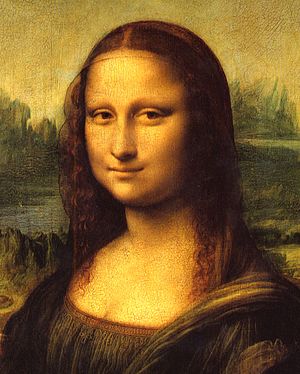 Image via WikipediaI was just listening to a quite marvellous piece of music by Brian Eno. I won't tell you what - it's likely not relevant.
Image via WikipediaI was just listening to a quite marvellous piece of music by Brian Eno. I won't tell you what - it's likely not relevant.(Just because you place a little trust in my musings about social (etc) doesn't mean you trust my musical judgement - and unless we are connected on a music sharing service, why should you?)
Whatever the case, most commentators on popular music would acknowledge Brian Eno has contributed works 'of significance'.
In a similar though perhaps clearer way, Leonardo's Mona Lisa is - whether you like or loathe it - acknowledged as a work of significance.
There is something uplifting and unifying in the idea that a piece of music, art, work of literature or person is of such significance that it is afforded near universal value by the majority of humanity.
But this is challenged by this networked age of ours - an age equipped with the tools to surface and scale relevance.
To understand the shifting sands of 'Significance' we must take a step back and explore how Significance has been acquired.
The Mona Lisa has been surfaced as significant by the machines of mass media and production.
Centrally contrived notions of what makes good art, who is a fine artist etc have been codified in the universities and art colleges. Those agreed notions are broadcast through traditional channels – the books from which the next generations of art professionals are taught, the filtering and selection of our iconography sorted to suit the lowest common denominator.
Who and what does Hollywood make movies about. Who and what are most often granted significance by other mass broadcast platforms?
“It’s important because we say it is” is a mantra once (still?) heard in newspaper offices. The centre selects what is of import, what is of significance – repeats and echoes that. The selection is based not on what is validated as important more on what is assumed to match lowest common denominator descriptions of what is important.
The same is true of how we come to select the significant icons of our culture – our shared broadcast, of the many culture.
Which all sounds quite negative. But didn’t it give us a Ghandi for every Cheryl Cole, a Mona Lisa for every ‘Dogs playing poker’?
Yes. But who am I to say thank you for that? I am but one person who happens, on this occasion, to concur with the lowest common denominator view that Ghandi is a wise selection as a person of significance and the Mona Lisa deserves her place in La Louvre.
As we see time and time again, as the long tail extends – as we learn to make use of the tools to scale relevance – the lowest common denominator shrinks until it is no longer the majority. It may retain its place as the single largest group – but it will not dominate.
Indeed the notion of a shared one-size-fits-all culture – particularly confined by and within geographic locations, is challenged by the network – by our ability to scale relevance.
There may be one salvation – a way in which this journey is a not a one-way ticket to nothing of truly iconic significance emerging in our future niche-dominated world; our human nature.
My good friend Mark Earls (author of Herd) would remind us that our inherent desire to be like the monkeys alongside us makes us more willing to accept as majority view. But even that will require us to be exposed to that majority view.
Right now, we are. Twitter trends reveals the single largest groups and we take a peek.
But in a world in which twitter ‘trends among friends’ are the only ones exposed to us, our iconography – our culture and its people, art, music and ideas of significance may come from within small self-forming adhoc groups.
Society, culture, call it what you will seems, to me at least, to be headed on a path away from homogenity – at least as measured within geographic boundaries.


A few years back I did a presentation on beauty and the internet so a lot of this post resonates strongly. I could talk about the end of contiguous culture but getting to the point only last week I was thinking how the Mona Lisa doesn't really do it for me but I'm absolutely certain that in a less visually rich artistic world when it was made, it would have blown my socks off.
ReplyDeleteIt's a great painting but then so are some of the profile pics on Twitter and Facebook.
Good thoughtful post.